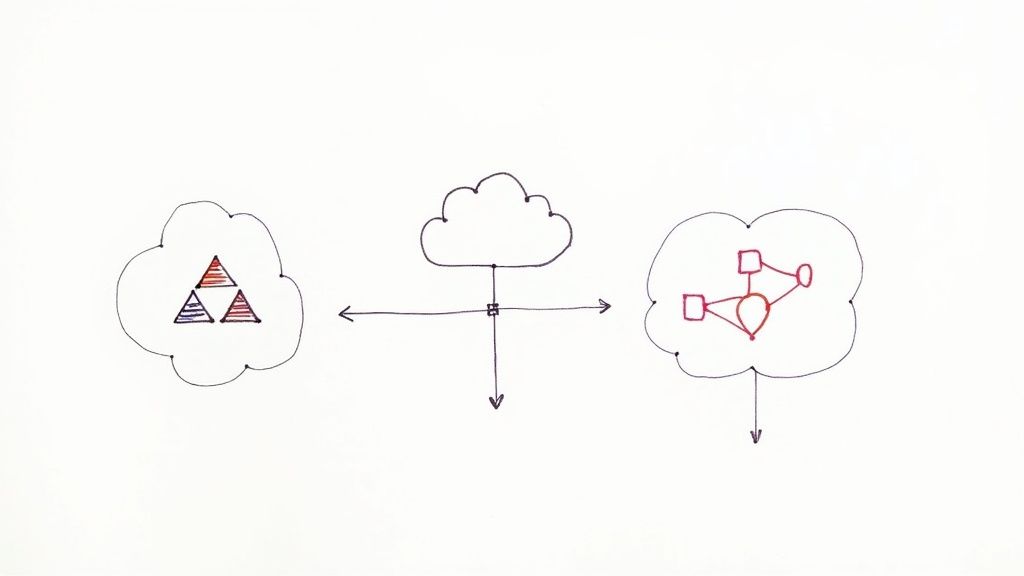Top 10 Best Practices in Data Warehousing for 2025

Discover 10 expert-backed best practices in data warehousing. Master dimensional modeling, real-time CDC, and cloud architecture to build a modern DW.
In today's data-driven landscape, a well-architected data warehouse is no longer a luxury-it's the core engine for competitive advantage. However, building one that is scalable, reliable, and delivers timely insights requires moving beyond outdated methods. Traditional batch processing and rigid schemas are giving way to agile, cloud-native solutions that demand a modern approach.
Getting it right means empowering your organization with trustworthy data for everything from strategic planning to real-time operational decisions. When executed poorly, a data warehouse becomes a costly data swamp-slow, unreliable, and a source of organizational friction. When implemented correctly, it transforms disparate data silos into a cohesive strategic asset that fuels growth and innovation.
This guide cuts through the noise to provide a definitive list of best practices in data warehousing, offering actionable strategies to help you build a high-performance analytics foundation that truly drives business value. We will explore ten critical areas, providing a comprehensive roadmap for constructing and maintaining an effective system.
Readers will learn concrete techniques for:
- Foundational design using dimensional and Data Vault modeling.
- Efficient data integration through optimized ETL/ELT processes and Change Data Capture (CDC).
- Ensuring data integrity with robust governance and quality management.
- Achieving peak performance via query tuning and scalable cloud architectures.
- Delivering timely insights with real-time and near-real-time data synchronization strategies.
Each practice is detailed with practical implementation steps and real-world context, equipping data engineers, analysts, and IT leaders with the knowledge needed to build a data warehouse that meets the demands of 2025 and beyond.
1. Dimensional Modeling (Star Schema)
Dimensional modeling, championed by Ralph Kimball, is a foundational design technique in data warehousing. It structures data to reflect business processes, making it intuitive for analytics and reporting. This approach organizes data into two primary components: fact tables, which store quantitative business metrics (the "facts"), and dimension tables, which hold descriptive attributes that provide context to those facts. The resulting structure, when visualized, resembles a star, with a central fact table connected to multiple surrounding dimension tables, hence the name "star schema."
This structure is one of the most crucial best practices in data warehousing because it deliberately denormalizes data to optimize query performance. Unlike the highly normalized structures found in transactional systems (OLTP), a star schema minimizes the number of table joins required for a query, drastically speeding up data retrieval for business intelligence (BI) tools and analytical applications.

Why Use Dimensional Modeling?
The primary goal of a data warehouse is to support high-performance analysis, not rapid transaction processing. The star schema directly serves this purpose by simplifying the database structure. For example, a retail company can analyze sales revenue (a fact) across various dimensions like product, store, customer, and time period without complex, multi-table joins. This simplicity not only improves query speed but also makes the data model easier for business analysts to understand and use.
Actionable Implementation Tips
To effectively implement a star schema, follow these specific guidelines:
- Focus on Business Processes: Begin by identifying and modeling your most critical business processes, such as "processing an order" or "handling an insurance claim." The metrics from these processes become the facts in your fact table.
- Design Conformed Dimensions: Create standardized, reusable dimension tables (e.g., a single "Date" dimension) that can be shared across multiple fact tables. This ensures consistency and enables cross-functional analysis.
- Use Surrogate Keys: Assign unique, system-generated integer keys (surrogate keys) as the primary keys in your dimension tables. This decouples the data warehouse from the operational source systems, protecting it from changes and improving join performance.
- Plan for Historical Tracking: Decide how you will handle changes in dimension attributes, known as Slowly Changing Dimensions (SCDs). For example, if a customer moves, do you overwrite the old address (SCD Type 1) or add a new record to preserve history (SCD Type 2)? Your choice should align with business reporting requirements.
2. Extract, Transform, Load (ETL) Process Design
Extract, Transform, Load (ETL) is the foundational engine that powers a data warehouse by moving data from diverse source systems into a centralized analytical environment. This process involves three distinct stages: Extract, where raw data is retrieved from its origins; Transform, where it is cleaned, standardized, and enriched according to business rules; and Load, where the prepared data is deposited into the target data warehouse.
A well-designed ETL process is one of the most critical best practices in data warehousing because it directly ensures data quality, consistency, and reliability. It acts as the gatekeeper, preventing flawed or inconsistent data from corrupting the analytical repository and guaranteeing that business decisions are based on trustworthy information. You can learn more about how to set up an effective ETL pipeline here.

Why Use a Structured ETL Process?
The core purpose of a structured ETL process is to enforce data integrity and apply complex business logic that source systems are not equipped to handle. For instance, a retail company can use ETL to consolidate transaction data from thousands of stores, standardize product codes, and calculate profit margins before loading the final dataset. This pre-processing makes the data immediately usable for analysis and prevents BI tools from being burdened with transformation logic, leading to faster and more consistent reporting.
Actionable Implementation Tips
To design a robust and efficient ETL process, follow these specific guidelines:
- Implement Incremental Loading: Instead of reloading entire datasets, process only new or changed data (deltas) since the last run. This significantly reduces processing time, network traffic, and resource consumption.
- Build In Data Quality Checks: Integrate validation rules directly into the transformation stage to identify and handle anomalies, such as missing values, incorrect formats, or outlier data, before they enter the warehouse.
- Leverage Staging Areas: Use intermediary staging tables to land raw data before transformation. This provides a buffer, simplifies debugging complex transformations, and allows for easier process restarts in case of failure.
- Establish Data Lineage: Document and track the flow of data from its source to the final target tables. This is crucial for auditing, troubleshooting issues, and understanding the impact of changes in source systems.
- Plan for Robust Error Handling: Design a comprehensive error-handling framework that captures, logs, and sends notifications for failures. Automate remediation steps for common issues where possible.
3. Data Quality Management and Governance
Data quality management is the discipline of establishing processes and controls to ensure the data within your warehouse is accurate, complete, consistent, and trustworthy. It is complemented by data governance, which provides the overarching framework of roles, responsibilities, and policies for managing data as a critical organizational asset. Together, they form the foundation for reliable analytics and decision-making.
This combination is one of the most vital best practices in data warehousing because even a perfectly designed architecture is useless if the data it holds is flawed. Poor data quality leads to inaccurate reports, flawed business intelligence, and a fundamental lack of trust from end-users. A robust governance program ensures that data is not only clean but also managed securely and ethically throughout its lifecycle.

Why Use Data Quality Management and Governance?
The core objective of data quality and governance is to build and maintain user trust in the data warehouse. When business leaders trust the data, they can confidently make strategic decisions based on analytics. For example, a financial institution relies on high-quality customer data to create a single customer view for anti-money laundering (AML) compliance, while a healthcare provider needs pristine patient data governance for HIPAA compliance. These frameworks transform data from a simple byproduct of operations into a managed, reliable corporate asset.
Actionable Implementation Tips
To effectively implement data quality and governance, follow these specific guidelines:
- Start with High-Value Data: Don't try to govern everything at once. Identify your most critical data assets, such as "customer" or "product" data, and begin your quality and governance initiatives there to demonstrate immediate business value.
- Build Quality Checks into ETL/ELT: Integrate data validation, standardization, and cleansing rules directly into your data ingestion pipelines. It is far more efficient to prevent bad data from entering the warehouse than to clean it up later.
- Establish Data Stewardship: Create a data stewardship council with representatives from both business and IT departments. These stewards are responsible for defining data rules, resolving quality issues, and championing data policies within their respective domains.
- Implement Automated Monitoring: Use data quality tools to automate the monitoring of key quality metrics like completeness, uniqueness, and validity. Set up alerts to notify data stewards when anomalies are detected, moving from a reactive to a proactive approach.
- Define Retention and Sanitization Policies: Beyond data validation, robust data governance also encompasses policies for data retention and secure data sanitization practices, ensuring sensitive information is irrevocably removed when no longer needed.
4. Incremental Load Strategy with Change Data Capture (CDC)
An incremental load strategy is an ETL/ELT process that moves only new or modified data from source systems to the data warehouse since the last update. Instead of reloading entire datasets, which is inefficient and resource-intensive, this method relies on Change Data Capture (CDC) to identify and extract just the changes. This approach dramatically reduces processing time, minimizes network load, and ensures the data warehouse remains current with minimal latency.
This technique is one of the most impactful best practices in data warehousing for achieving near-real-time analytics and operational efficiency. By processing smaller, targeted data volumes, organizations can update their warehouses more frequently, such as hourly or even minute-by-minute, without overburdening source systems or incurring excessive cloud computing costs. This keeps analytical dashboards and reports consistently fresh and reliable for decision-making.
Why Use an Incremental Load Strategy?
The core benefit is efficiency. Full data reloads are unsustainable as data volumes grow, leading to long batch windows and stale data. For example, an e-commerce platform can use CDC to instantly sync product inventory changes, preventing overselling. Similarly, a financial institution can incrementally load transaction data throughout the day, enabling up-to-the-minute fraud detection rather than waiting for an overnight batch process. This method scales effectively and supports the demand for timely business intelligence.
Actionable Implementation Tips
To successfully implement an incremental load strategy using CDC, follow these guidelines:
- Choose the Right CDC Method: If direct access to database transaction logs is available (log-based CDC), use it for the lowest latency and minimal impact on the source system. If not, start with a query-based approach using timestamps or version numbers, but be mindful of the potential performance overhead.
- Implement Auditing and Versioning: Build a robust auditing mechanism to track every change captured and loaded. For dimension tables, use explicit versioning or Slowly Changing Dimension (SCD) Type 2 techniques to preserve historical context and ensure data integrity.
- Plan for Recovery and Monitoring: Thoroughly test your failure recovery procedures. Ensure you can re-sync data from the last successful load point without data loss or duplication. Implement comprehensive logging and monitoring to track CDC operations and quickly troubleshoot any issues.
- Use Surrogate Keys for Clean Updates: Continue using surrogate keys in your warehouse. They decouple the warehouse from source system keys and simplify the process of applying updates and deletes identified by the CDC process, preventing data integrity conflicts. Learn more about the technical specifics of Change Data Capture for SQL databases.
5. Metadata Management and Data Lineage
Metadata, often described as "data about data," is the contextual information that describes the structure, content, quality, and origin of your data assets. Data lineage complements this by providing a complete audit trail, tracking the data's journey from its source systems, through various transformations, and into its final destination in reports and dashboards. Together, they create a transparent, trustworthy, and governable data environment.
Implementing robust metadata management and data lineage is one of the most critical best practices in data warehousing because it builds trust and enables self-service analytics. When users understand where data comes from, what it means, and how it has been changed, they can confidently use it for decision-making. This transparency is also essential for regulatory compliance, debugging data pipelines, and performing impact analysis before making changes.
Why Use Metadata Management and Data Lineage?
A data warehouse without metadata is like a library with no card catalog; the information is there, but finding and trusting it is nearly impossible. For example, a financial institution can use data lineage to prove to auditors how a specific number in a regulatory report was calculated, tracing it back to the original transaction. Similarly, a healthcare provider can leverage metadata to ensure patient data is handled in compliance with HIPAA regulations.
Actionable Implementation Tips
To effectively implement metadata management and data lineage, consider these guidelines:
- Establish a Centralized Data Catalog: Deploy a data catalog tool like Collibra, Alation, or an open-source solution like Apache Atlas. This provides a single, searchable repository for all metadata.
- Automate Metadata and Lineage Capture: Manually documenting data flows is unsustainable. Use tools that automatically scan your data sources, ETL/ELT pipelines, and BI tools to capture technical metadata and build lineage graphs.
- Track Both Business and Technical Metadata: Go beyond just column names and data types (technical metadata). Capture business definitions, ownership, and quality rules (business metadata) to provide a complete picture for all users.
- Use Lineage for Impact Analysis: Before modifying a table or a transformation rule, use the lineage map to identify all downstream reports, dashboards, and data marts that will be affected. This prevents unexpected breakages and maintains system integrity.
6. Scalable Architecture and Cloud-Based Solutions
Modern data warehousing has shifted from rigid, on-premises systems to flexible, cloud-based architectures. This approach leverages cloud platforms to separate storage and compute resources, allowing each to scale independently. This decoupling means organizations can handle massive data volumes at rest (storage) while elastically scaling processing power (compute) up or down to meet fluctuating analytical demands, often on a pay-as-you-go basis.
This model is a cornerstone of best practices in data warehousing because it directly addresses the scalability and cost-efficiency limitations of traditional systems. Instead of over-provisioning expensive hardware for peak loads, cloud solutions like Snowflake, Google BigQuery, and Amazon Redshift provide the agility to align resources precisely with current workloads, transforming capital expenditures into operational ones.
Why Use a Scalable Cloud Architecture?
The primary driver for adopting a scalable cloud architecture is business agility. A media company can instantly scale compute resources to analyze a massive influx of streaming data after a major event and then scale back down to control costs. This elasticity ensures high-performance analytics are always available without the long procurement cycles and fixed capacity constraints of on-premises infrastructure. Furthermore, these platforms democratize access to powerful analytics, enabling organizations of all sizes to run complex queries that were once only feasible for large enterprises.
Actionable Implementation Tips
To effectively leverage a scalable cloud architecture, consider these specific guidelines:
- Separate Compute from Storage: Choose a cloud data warehouse that fully decouples compute and storage. This allows you to ingest and store terabytes or petabytes of data affordably while provisioning specific compute clusters for different teams (e.g., data science, BI) without resource contention.
- Implement Robust Governance and Security: From day one, implement strict access controls, data encryption at rest and in transit, and network security policies. Cloud environments require a proactive security posture to protect sensitive data.
- Monitor and Optimize for Cost: Actively use resource management features like virtual warehouses, query queues, and auto-suspension to control costs. Analyze query patterns and performance logs to identify and optimize inefficient queries that consume excessive compute credits.
- Plan for Data Egress Costs: While data ingress is often free, be mindful of data transfer (egress) costs when moving data out of the cloud platform or between regions. Factor this into your architecture, especially in multi-cloud or hybrid environments.
7. Data Vault Modeling for Complex Enterprises
Data Vault, a modeling methodology developed by Dan Linstedt, provides an agile and scalable alternative to traditional dimensional modeling. It is specifically designed to handle the complexities of enterprise-level data integration from numerous source systems. This approach organizes data into three core components: Hubs (unique business keys), Links (relationships between Hubs), and Satellites (descriptive, historical attributes), creating a flexible, auditable, and extensible raw data layer.
This methodology is one of the most important best practices in data warehousing for organizations facing constant change, such as mergers, acquisitions, or evolving regulatory landscapes. Unlike a star schema, which is optimized for reporting, a Data Vault is optimized for integration and historical tracking. It captures raw data "as is" from source systems, providing a complete audit trail and preventing the loss of historical context when business rules change.
Why Use Data Vault Modeling?
The primary strength of Data Vault is its adaptability. In large enterprises, source systems are constantly added or modified. A Data Vault architecture allows new data sources to be integrated with minimal disruption to the existing structure. For instance, a global financial institution can easily add a new trading platform's data into its warehouse without redesigning the entire core model. This agility significantly reduces development time and supports long-term data consistency and auditability.
Actionable Implementation Tips
To successfully implement a Data Vault model, follow these specific guidelines:
- Isolate the Raw Vault: Use the Data Vault exclusively for your raw data integration layer. Build business-facing data marts, often as star schemas, on top of it for simplified end-user reporting and BI analytics.
- Invest in Training: The Data Vault methodology involves concepts and patterns that may be unfamiliar to teams experienced only with dimensional modeling. Proper training is crucial for successful adoption and long-term maintenance.
- Leverage Automation: The component-based, repeatable patterns of Data Vault make it highly suitable for automation. Use code generation tools to create hubs, links, and satellites consistently, which reduces errors and accelerates development.
- Define Business Keys Rigorously: The foundation of a good Data Vault is well-defined Hubs. Spend significant time with business stakeholders to identify and document the true business keys (e.g., Customer Number, Product SKU) that uniquely identify core business concepts across the enterprise.
8. Performance Optimization and Query Tuning
A data warehouse's value is directly tied to its performance. Slow queries and lagging dashboards frustrate users and hinder timely decision-making. Performance optimization and query tuning involve a set of techniques, from indexing and partitioning to workload management, designed to ensure that data retrieval is fast, efficient, and reliable, even as data volumes and query complexity grow.
This discipline is one of the most critical best practices in data warehousing because it directly impacts business agility. When a retail analytics team can reduce dashboard load times from minutes to seconds, or a financial institution can run real-time fraud detection queries without system degradation, the data warehouse moves from being a historical repository to a strategic business asset. It's about maximizing throughput and minimizing latency.
Why Prioritize Performance Optimization?
The primary purpose of a data warehouse is to provide quick and easy access to large volumes of integrated data for analysis. Without deliberate optimization, queries can become resource-intensive bottlenecks, slowing down the entire system. By tuning queries and optimizing the underlying infrastructure, organizations can support thousands of concurrent ad-hoc queries, empower self-service BI, and ensure that critical reports are delivered on time without monopolizing system resources.
Actionable Implementation Tips
To effectively tune your data warehouse for peak performance, implement these strategies:
- Analyze Query Execution Plans: Before deploying a complex query, use your database's
EXPLAINor equivalent command. This reveals the query optimizer's strategy, helping you identify inefficient steps like full table scans or suboptimal join methods. - Implement Materialized Views Strategically: For frequently run, complex aggregations (e.g., monthly sales summaries), create materialized views. These pre-computed tables serve results instantly, avoiding the need to re-calculate the same data for every request.
- Design a Smart Partitioning Strategy: Partition large fact tables based on common query filters, most often a date column (e.g., partition by month). This allows the query engine to scan only the relevant partitions, dramatically reducing I/O.
- Use Workload Management (WLM): Configure WLM rules to prioritize critical queries and prevent resource-hogging ad-hoc queries from impacting operational reporting. This ensures high-priority tasks always have the necessary CPU and memory.
9. Data Mart Strategy and Federated Architectures
While an enterprise-wide data warehouse (EDW) provides a single source of truth, it can become a bottleneck as business needs grow. A data mart strategy, often implemented within a federated architecture, addresses this by creating smaller, subject-oriented data warehouses for specific departments or business units like marketing, sales, or operations. Each data mart sources its data from the central EDW or a common staging area, ensuring consistency while granting departments the autonomy to build analytics tailored to their needs.
This approach is one of the most effective best practices in data warehousing for large, complex organizations. It decentralizes development and empowers individual teams to move faster, while a central governance body maintains enterprise-wide data standards. A federated architecture connects these independent data marts, allowing for cross-functional analysis without forcing every department into a monolithic, one-size-fits-all model.
Why Use a Data Mart Strategy?
The primary goal of a data mart is to deliver highly relevant, curated data to a specific group of users quickly and efficiently. For example, a hospital can have separate data marts for clinical analysis, financial reporting, and patient administration. Each mart contains only the data pertinent to its users, simplifying models and dramatically improving query performance for their specific use cases. This targeted approach boosts user adoption and delivers business value more rapidly than waiting for a centralized team to fulfill every request.
Actionable Implementation Tips
To effectively implement a data mart and federated architecture, follow these guidelines:
- Establish Conformed Dimensions: Before building any marts, define and create shared, conformed dimensions (e.g., Customer, Product, Date) that will be used universally. This is the cornerstone of a successful federated model, ensuring all marts speak the same business language.
- Create a Shared Staging Layer: Design a central staging or integration layer where data from source systems is cleaned and prepared. This layer becomes the trusted source from which all data marts are populated, preventing redundant ETL processes.
- Implement Strong Central Governance: While granting autonomy, establish a data governance council to enforce standards for data definitions, quality, and security across all marts. This prevents the architecture from devolving into disconnected data silos.
- Plan for Cross-Mart Integration: From the start, design how data will be shared and queried across different marts. Utilize APIs, data virtualization, or a common metadata repository to facilitate enterprise-level analytics when needed.
10. Real-Time and Near-Real-Time Data Warehousing
Traditional data warehouses operate on a batch-oriented schedule, processing data periodically, such as nightly or hourly. In contrast, a real-time data warehousing architecture ingests and processes data continuously, enabling immediate insights for time-sensitive business decisions. This approach moves beyond scheduled ETL jobs to a continuous flow of information, supporting analytics that reflect the current state of the business.
This shift represents one of the most transformative best practices in data warehousing because it aligns analytics capabilities with the pace of modern business operations. By leveraging streaming infrastructure like Apache Kafka and low-latency processing engines, organizations can power use cases that were previously impossible, such as fraud detection, live inventory management, and real-time threat analysis.
Why Use Real-Time Data Warehousing?
The primary driver for real-time analytics is the need for immediate, data-driven action. For instance, a financial trading platform must monitor market data for millisecond-level decisions, while a cybersecurity operations center needs to detect threats the instant they occur. This immediacy provides a significant competitive advantage by enabling proactive responses rather than reactive analysis of historical data. The architecture supports business agility by making fresh data constantly available for operational BI and automated decisioning systems. To explore this topic further, you can learn more about real-time data streaming.
Actionable Implementation Tips
To effectively build a real-time or near-real-time data warehouse, consider these guidelines:
- Evaluate True Latency Needs: Before over-engineering a solution, carefully assess the actual business requirements. Differentiate between true real-time (milliseconds) and near-real-time (seconds to minutes) needs to select the appropriate technology stack.
- Use a Durable Streaming Platform: Implement a tool like Apache Kafka or AWS Kinesis to act as a durable, replayable event stream. This buffer is critical for decoupling data producers and consumers and ensuring data integrity during system failures.
- Implement a Hybrid Model: Not all data requires real-time processing. Adopt a hybrid approach where critical, high-value metrics are streamed in real-time, while less urgent data is loaded in batches. This optimizes cost and complexity.
- Design for Fault Tolerance: Build systems with exactly-once processing semantics and idempotent operations to prevent data duplication or loss during failures. Thoroughly test failure scenarios, including network latency and node outages, to ensure resilience.
10-Point Comparison of Data Warehousing Best Practices
Building a Future-Proof Data Warehouse
The journey through the essential best practices in data warehousing reveals a clear narrative: success is not about implementing a single, perfect solution. Instead, it’s about architecting a cohesive, adaptable ecosystem where each component reinforces the others. We’ve explored the foundational bedrock of dimensional modeling, the disciplined engine of ETL/ELT processes, and the crucial guardrails of robust data governance. These are the timeless principles that ensure reliability and consistency.
However, a modern data warehouse cannot stand on these foundations alone. It must be dynamic and responsive to the accelerating pace of business. This is where advanced practices like incremental loading with Change Data Capture (CDC), scalable cloud architectures, and the strategic use of data marts come into play. They transform the data warehouse from a static historical repository into a living, breathing analytical powerhouse. By weaving these elements together, you build a system that is not only powerful today but also resilient enough to adapt to future challenges.
Synthesizing the Core Principles
The true power of these practices is realized when they are integrated into a holistic strategy. A well-designed Star Schema is only as good as the quality of the data flowing into it. Similarly, a high-performance cloud platform won't deliver value if queries are poorly optimized or metadata is non-existent.
Here are the key takeaways that bridge these concepts:
- Foundation First, Innovation Next: Master the fundamentals like dimensional modeling and data governance before chasing advanced features. A strong foundation prevents technical debt and makes future scaling far more manageable.
- Embrace Agility and Scalability: Cloud-native solutions and federated architectures provide the elasticity needed to grow with your data and user base. Avoid monolithic designs that lock you into a single technology or vendor.
- Data Freshness is a Competitive Edge: The shift from traditional batch processing to real-time and near-real-time data ingestion is no longer a luxury. Leveraging CDC and streaming pipelines is critical for enabling timely, actionable insights that drive immediate business decisions.
- Governance is an Enabler, Not a Blocker: Strong metadata management, data lineage, and quality controls are not bureaucratic hurdles. They are essential tools that build trust, accelerate discovery, and empower users to confidently leverage data.
Your Actionable Path Forward
Moving from theory to implementation can feel daunting. The key is to take a phased, intentional approach. Start by assessing your current environment against the practices discussed. Identify the most significant pain points. Is it slow data delivery? Poor query performance? A lack of trust in your data?
Prioritize your efforts based on business impact. Perhaps implementing a robust data quality framework is the most critical first step. Or maybe your priority is migrating from cumbersome batch ETL to an efficient, real-time CDC pipeline to feed your BI dashboards with fresh data. As you evolve your strategy, it's also vital to keep an eye on emerging trends that will shape the future of analytics. To ensure your data warehouse remains future-proof, it's important to consider emerging technologies and their impact, such as the evolving the role of Artificial Intelligence in data strategies.
Ultimately, building a future-proof data warehouse is a continuous commitment to excellence. It’s about creating a culture of data-driven decision-making, supported by a technical architecture that is both powerful and pliable. By mastering these best practices in data warehousing, you are not just building a repository for data; you are building a strategic asset that will fuel innovation, efficiency, and competitive advantage for years to come.
Ready to modernize your data pipeline and embrace real-time analytics? Streamkap uses Change Data Capture (CDC) to stream data from your databases to your data warehouse in real-time, with sub-second latency. See how easy it is to implement one of the most critical best practices by visiting Streamkap and starting your free trial today.



